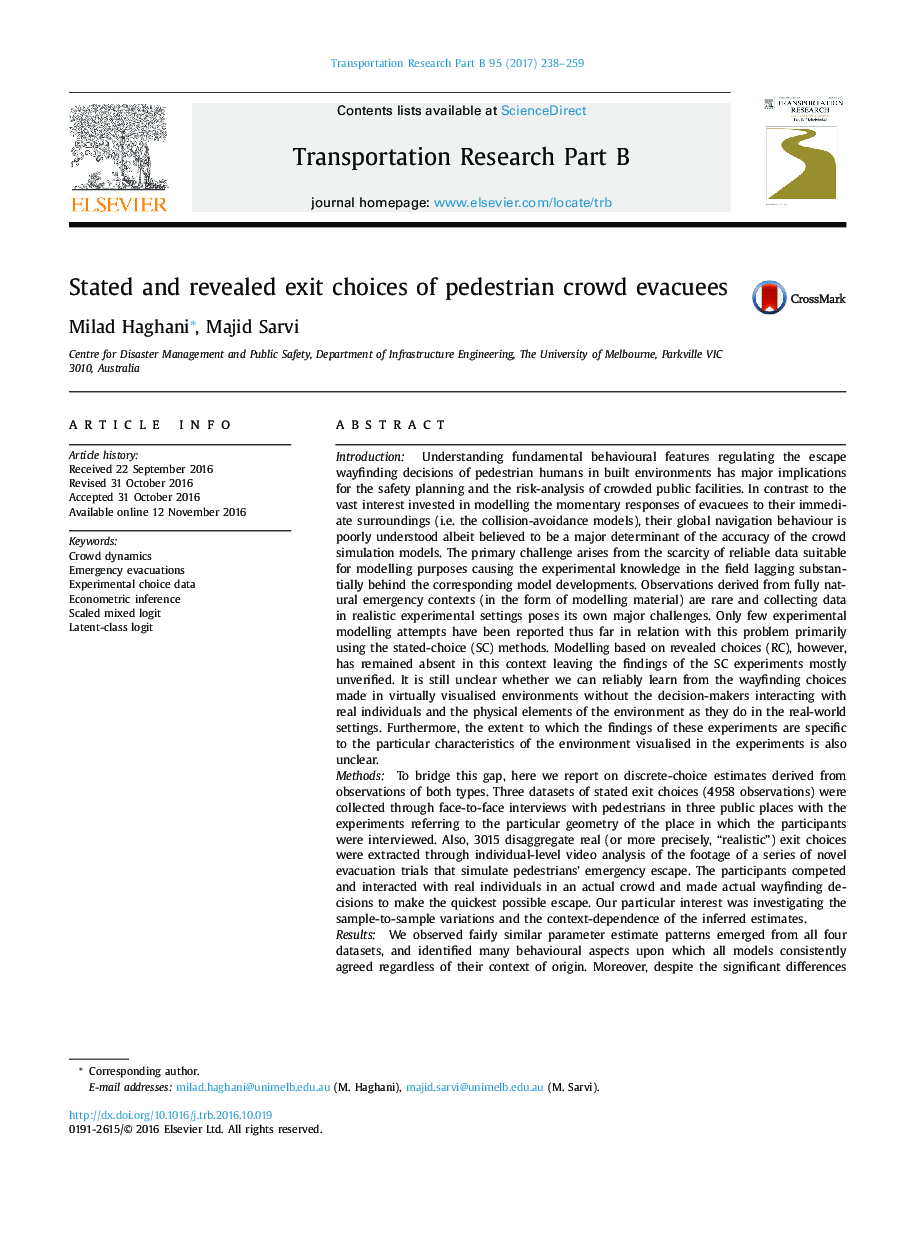| کد مقاله | کد نشریه | سال انتشار | مقاله انگلیسی | نسخه تمام متن |
|---|---|---|---|---|
| 5127099 | 1488951 | 2017 | 22 صفحه PDF | دانلود رایگان |
- Conducting hypothetical and realistic emergency exit choice experiments of evacuees.
- Stated and real choice observations generated fairly similar patterns of estimates.
- Stated and real observations generated fairly similar probabilities.
- Significant context-dependent differences were observed between the parameter scales.
- Preference heterogeneity of evacuees was found reducible to only two behavioural classes.
IntroductionUnderstanding fundamental behavioural features regulating the escape wayfinding decisions of pedestrian humans in built environments has major implications for the safety planning and the risk-analysis of crowded public facilities. In contrast to the vast interest invested in modelling the momentary responses of evacuees to their immediate surroundings (i.e. the collision-avoidance models), their global navigation behaviour is poorly understood albeit believed to be a major determinant of the accuracy of the crowd simulation models. The primary challenge arises from the scarcity of reliable data suitable for modelling purposes causing the experimental knowledge in the field lagging substantially behind the corresponding model developments. Observations derived from fully natural emergency contexts (in the form of modelling material) are rare and collecting data in realistic experimental settings poses its own major challenges. Only few experimental modelling attempts have been reported thus far in relation with this problem primarily using the stated-choice (SC) methods. Modelling based on revealed choices (RC), however, has remained absent in this context leaving the findings of the SC experiments mostly unverified. It is still unclear whether we can reliably learn from the wayfinding choices made in virtually visualised environments without the decision-makers interacting with real individuals and the physical elements of the environment as they do in the real-world settings. Furthermore, the extent to which the findings of these experiments are specific to the particular characteristics of the environment visualised in the experiments is also unclear.MethodsTo bridge this gap, here we report on discrete-choice estimates derived from observations of both types. Three datasets of stated exit choices (4958 observations) were collected through face-to-face interviews with pedestrians in three public places with the experiments referring to the particular geometry of the place in which the participants were interviewed. Also, 3015 disaggregate real (or more precisely, “realistic”) exit choices were extracted through individual-level video analysis of the footage of a series of novel evacuation trials that simulate pedestrians' emergency escape. The participants competed and interacted with real individuals in an actual crowd and made actual wayfinding decisions to make the quickest possible escape. Our particular interest was investigating the sample-to-sample variations and the context-dependence of the inferred estimates.ResultsWe observed fairly similar parameter estimate patterns emerged from all four datasets, and identified many behavioural aspects upon which all models consistently agreed regardless of their context of origin. Moreover, despite the significant differences between the parameter scales of the four models, the SC-generated models made predictions that were reasonably similar to those of the RC model as well as to those of the model derived from the combined data.ApplicationsOur findings provide promising evidence as to the potential applicability of the SC methods in particular as well as other forms of virtual-reality decision experiments in general as a practical, flexible and ethical approach for the continuation of research and advancing the state of knowledge in this field.
Journal: Transportation Research Part B: Methodological - Volume 95, January 2017, Pages 238-259
